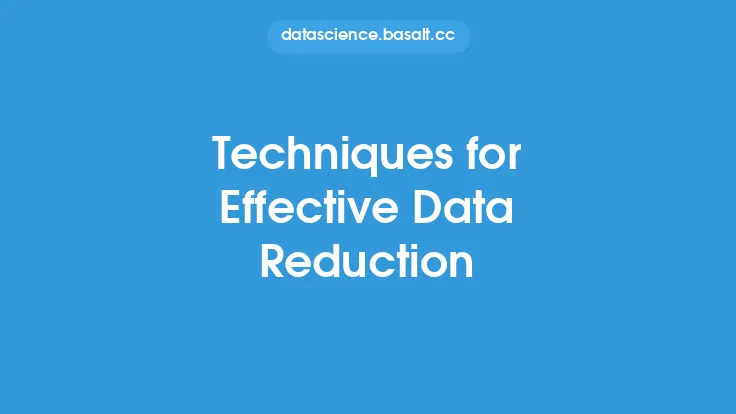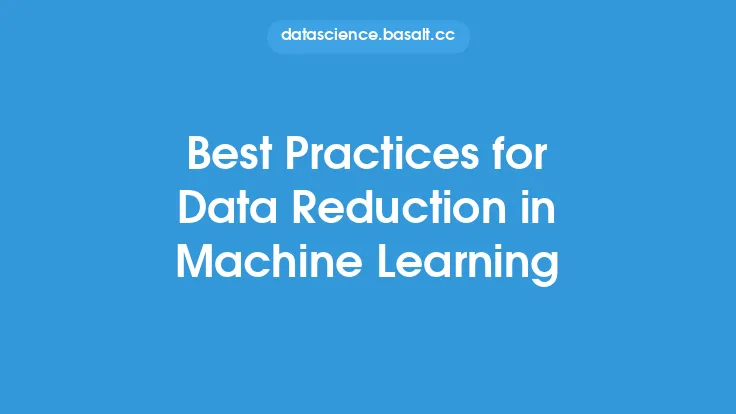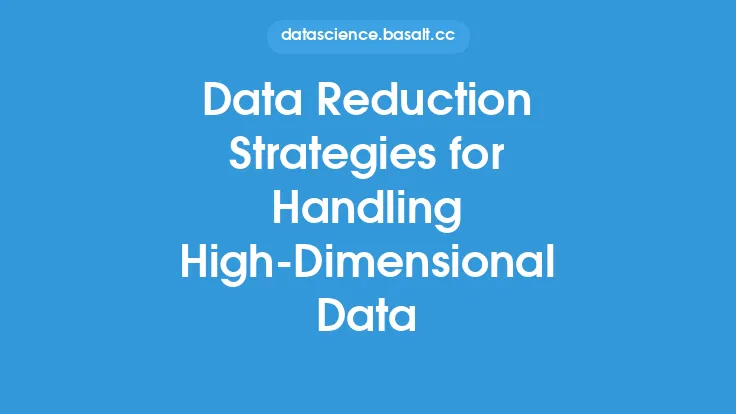Data reduction is a crucial step in the data mining process, as it enables analysts to extract valuable insights from large datasets by reducing the volume of data while preserving its integrity. With the exponential growth of data in various industries, data reduction has become an essential technique for efficient data analysis. In this article, we will delve into the various data reduction techniques that can be employed to achieve efficient data analysis.
Introduction to Data Reduction Techniques
Data reduction techniques are methods used to reduce the size of a dataset while maintaining its essential characteristics. These techniques are designed to eliminate redundant, irrelevant, or noisy data, resulting in a more manageable and informative dataset. The primary goal of data reduction is to improve the accuracy and efficiency of data analysis, as well as to reduce the computational resources required for processing large datasets. Data reduction techniques can be broadly categorized into two main types: data aggregation and data transformation.
Data Aggregation Techniques
Data aggregation techniques involve combining multiple data points into a single value, such as calculating the mean or sum of a set of values. These techniques are useful for reducing the volume of data while preserving its overall characteristics. Some common data aggregation techniques include:
- Data binning: This involves dividing a continuous variable into a set of discrete bins, each representing a range of values. Data binning is useful for reducing the number of unique values in a dataset.
- Data grouping: This involves grouping similar data points together based on one or more attributes. Data grouping is useful for identifying patterns and trends in a dataset.
- Data sampling: This involves selecting a representative subset of data points from a larger dataset. Data sampling is useful for reducing the volume of data while preserving its overall characteristics.
Data Transformation Techniques
Data transformation techniques involve converting data from one format to another, such as converting categorical variables into numerical variables. These techniques are useful for reducing the dimensionality of a dataset and improving its quality. Some common data transformation techniques include:
- Normalization: This involves scaling numeric data to a common range, usually between 0 and 1, to prevent differences in scales from affecting the analysis.
- Feature scaling: This involves scaling numeric data to have zero mean and unit variance, which can improve the performance of machine learning algorithms.
- Log transformation: This involves transforming skewed data to a more normal distribution, which can improve the accuracy of statistical models.
Dimensionality Reduction Techniques
Dimensionality reduction techniques involve reducing the number of features or variables in a dataset while preserving its essential characteristics. These techniques are useful for improving the performance of machine learning algorithms and reducing the risk of overfitting. Some common dimensionality reduction techniques include:
- Principal Component Analysis (PCA): This involves transforming a set of correlated variables into a new set of uncorrelated variables, called principal components, which capture the majority of the variance in the data.
- Singular Value Decomposition (SVD): This involves decomposing a matrix into the product of three matrices, which can be used to reduce the dimensionality of a dataset.
- t-Distributed Stochastic Neighbor Embedding (t-SNE): This involves transforming high-dimensional data into a lower-dimensional representation, which can be used for visualization and clustering.
Data Reduction Techniques for Categorical Data
Categorical data can be challenging to analyze, especially when dealing with high-cardinality variables. Data reduction techniques for categorical data involve reducing the number of unique categories or converting categorical variables into numerical variables. Some common data reduction techniques for categorical data include:
- Label encoding: This involves converting categorical variables into numerical variables by assigning a unique integer to each category.
- One-hot encoding: This involves converting categorical variables into numerical variables by creating a new binary variable for each category.
- Hashing: This involves converting categorical variables into numerical variables by using a hash function to map each category to a unique integer.
Evaluating the Effectiveness of Data Reduction Techniques
Evaluating the effectiveness of data reduction techniques is crucial to ensure that the reduced dataset preserves the essential characteristics of the original dataset. Some common metrics used to evaluate the effectiveness of data reduction techniques include:
- Retention of variance: This measures the amount of variance retained in the reduced dataset compared to the original dataset.
- Retention of information: This measures the amount of information retained in the reduced dataset compared to the original dataset.
- Computational efficiency: This measures the reduction in computational resources required for processing the reduced dataset compared to the original dataset.
Conclusion
Data reduction techniques are essential for efficient data analysis, as they enable analysts to extract valuable insights from large datasets while preserving their integrity. By applying data aggregation, data transformation, dimensionality reduction, and data reduction techniques for categorical data, analysts can improve the accuracy and efficiency of data analysis, as well as reduce the computational resources required for processing large datasets. By evaluating the effectiveness of data reduction techniques, analysts can ensure that the reduced dataset preserves the essential characteristics of the original dataset, leading to better decision-making and improved business outcomes.





